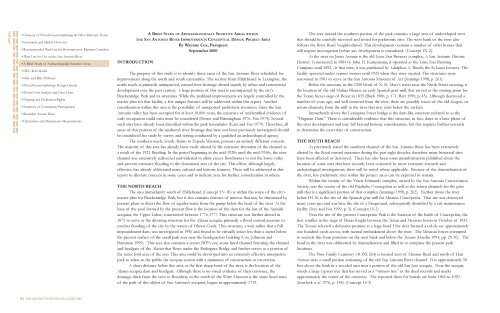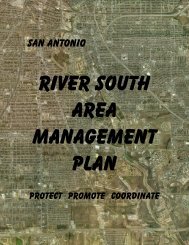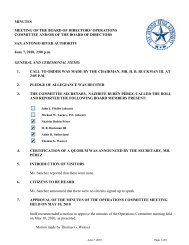concept design san antonio river improvements project
concept design san antonio river improvements project
concept design san antonio river improvements project
You also want an ePaper? Increase the reach of your titles
YUMPU automatically turns print PDFs into web optimized ePapers that Google loves.
APPENDIX<br />
• Glossary of Fluvial Geomorphologic & Other Relevant Terms<br />
• Economic and Market Overview<br />
• Recommended Plant List for Restoration of Riparian Corridors<br />
• Plant List for Use on the San Antonio River<br />
• A Brief Study of Archaeologically Sensitive Areas<br />
• HEC-RAS Model<br />
• Hike and Bike Pathways<br />
• Fluvial Geomorphology Design Criteria<br />
• Master Cost Analysis and Gant Chart<br />
• Naming and Dedication Rights<br />
• Summary of Community Participation<br />
• Brooklyn Avenue Dam<br />
• Operations and Maintenance Requirements<br />
112 SAN ANTONIO RIVER DESIGN GUIDELINES<br />
A BRIEF STUDY OF ARCHAEOLOGICALLY SENSITIVE AREAS WITHIN<br />
THE SAN ANTONIO RIVER IMPROVEMENTS CONCEPTUAL DESIGN PROJECT AREA<br />
By Waynne Cox, Pastquest<br />
September 2000<br />
INTRODUCTION<br />
The purpose of this study is to identify those areas of the San Antonio River scheduled for<br />
improvement along the north and south extremities. The section from Hildebrand to Lexington, the<br />
north reach, is primarily unimproved, natural <strong>river</strong> frontage altered mainly by urban and commercial<br />
development over the past century. A large portion of this tract is encompassed by the city’s<br />
Brackenridge Park and its amenities. While the parkland <strong>improvements</strong> are largely controlled by the<br />
master plan for that facility, a few unique features will be addressed within this report. Another<br />
consideration within this area is the possibility of unreported prehistoric resources. Since the San<br />
Antonio valley has been occupied for at least 10,000 years, the existence of unidentified evidence of<br />
early occupation could exist must be considered (Hester and Birmingham 1976, Fox 1975). Several<br />
such sites have already been identified within the park boundaries (Katz and Fox 1979). Therefore, all<br />
areas of this portion of the unaltered <strong>river</strong> frontage that have not been previously investigated should<br />
be considered for study by survey and testing conducted by a qualified an archaeological agency.<br />
The southern reach, South Alamo to Espada Mission, presents an entirely different concern.<br />
The majority of this area has already been vastly altered by the extensive alteration of the channel as<br />
a result of the 1921 flooding. In the period beginning in the mid-1920s until the mid-1950s, the <strong>river</strong><br />
channel was extensively redirected and widened to allow excess floodwaters to exit the lower valley<br />
and prevent extensive flooding to the downtown area of the city. This effort, although largely<br />
effective, has already obliterated many cultural and historic features. These will be addressed in this<br />
report to alleviate concern in some cases and to indicate area for further consideration in others.<br />
THE NORTH REACH<br />
The area immediately south of Hildebrand (Concept 1N-1b) is within the scope of the city’s<br />
master plan for Brackenridge Park, but it also contains features of interest that may be threatened by<br />
present plans to divert the flow of aquifer water from the pump below the head of the <strong>river</strong>. At the<br />
base of the pool formed by the present flow is the location of the dam for the last of the Spanish<br />
acequias, the Upper Labor, constructed between 1776-1777. This structure was further altered in<br />
1875 to serve as the diverting structure for the Alazan acequia, primarily a flood control measure to<br />
combat flooding of the city by the waters of Olmos Creek. This structure, a weir rather that a full<br />
impoundment dam, was investigated in 1996 and found to be virtually intact less than a meter below<br />
the present surface of the small park area near the headquarters building (Cox, Johnson and<br />
Bousman 1999). This area also contains a recent (WPA era) stone lined channel featuring the channel<br />
and headgate of the Alazan that flows under the Rodriguez Bridge and further serves as a portion of<br />
the water fowl area of the zoo. This area could be developed into an extremely effective interpretive<br />
park to relate to the public the acequia system with a minimum of construction or excavation.<br />
A short distance below this area, at the first sharp bend of the <strong>river</strong>, is the location of the<br />
Alamo acequia dam and headgate. Although there is no visual evidence of their existence, the<br />
drainage ditch from the <strong>river</strong> to Broadway to the north of the Witte Museum is the stone lined trace<br />
of the path of this oldest of San Antonio’s acequias, begun in approximately 1719.<br />
The area toward the southern portion of the park contains a large area of undeveloped <strong>river</strong><br />
that should be carefully surveyed and tested for prehistoric sites. The west bank of the <strong>river</strong> also<br />
follows the River Road Neighborhood. This development contains a number of older homes that<br />
will require investigation before any development is considered. (Concept 1N-2).<br />
At the <strong>river</strong> on Jones Avenue is the old Lone Star Brewery complex, A San Antonio Historic<br />
District. Constructed in 1884 by John H. Kampmann, it operated as the Lone Star Brewing<br />
Company until 1892. At that time, it was purchased by Adolphus A. Busch, the St.Louis brewery. The<br />
facility operated under various owners until 1925 when they were vacated. The structures were<br />
renovated in 1981 to serve as the San Antonio Museum of Art (Jennings 1998, p. 261).<br />
Below the museum, in the 1200 block of N. St. Mary’s street near the Ninth Street crossing, is<br />
the location of the old Molina Blanco, an early Spanish grist mill, that served as the starting point for<br />
the Texan forces siege of Bexar in 1835 (Buck 1980, p. 171; Barr 1990, p. 45). Although destroyed a<br />
number of years ago, and well removed from the <strong>river</strong>, there are possibly traces of the old desagues, or<br />
return channels, from the mill to the <strong>river</strong> that may exist below the surface.<br />
Immediately above the Lexington Street bridge is the dam-like structure referred to as the<br />
“Hugman Dam.” There is considerable evidence that this structure, in fact, dates to a later phase of<br />
the <strong>river</strong> development and may fall beyond historic consideration, but this requires further research<br />
to determine the exact date of construction.<br />
THE SOUTH REACH<br />
As previously stated the southern channel of the San Antonio River has been extensively<br />
altered by the flood control measures during the past eight decades, therefore many historical sites<br />
have been affected or destroyed. There has also been some misinformation published about the<br />
location of some sites that have recently been corrected by more extensive research and<br />
archaeological investigations; these will be noted where applicable. Because of the channelization of<br />
the <strong>river</strong>, few prehistoric sites within the <strong>project</strong> areas can be expected to remain.<br />
Within the vicinity of the Yturri-Edmunds complex, owned by the San Antonio Conservation<br />
Society, was the course of the old Pajalache/Conception as well as the return channels for the grist<br />
mill that is a significant portion of that complex (Jennings 1998, p. 262). Further down the <strong>river</strong><br />
below IH 10, is the site of the Spanish grist mill for Mission Concepción. That site was destroyed<br />
many years ago and was later the site of a Fairground, subsequently disturbed by a city maintenance<br />
facility (Ivey and Fox 1999, p. 5). (Concept 1S-2)<br />
Near the site of the present Concepción Park is the location of the battle of Concepción, the<br />
first conflict in the siege of Bexar fought between the Texan and Mexican forces in October of 1835.<br />
The Texans selected a defensive position at a large bend I the <strong>river</strong> formed a cul-de-sac approximately<br />
one hundred yards across, with natural embankment above the <strong>river</strong>. The Mexican forces attempted<br />
to encircle this from positions on the west bank and below the Texans (Hardin 1994, pp. 29-30). The<br />
bend in the <strong>river</strong> was obliterated by channelization and filled in to comprise the present park<br />
locations.<br />
The Poor Family Cemetery (41 BX 264) is located west of Mission Road and north of Hart<br />
Avenue near a small portion remaining of the old San Antonio River channel. It is approximately 50<br />
feet above the bank in a wooded area near a portion of the old San Jose acequia. Near the acequia<br />
stands a large cypress tree that has served as a “witness tree” in the deed records and marks<br />
approximately the center of the cemetery. The reported dates for burials are from 1865 to 1920<br />
(Scurlock et al. 1976, p. 158). (Concept 1S-3)






